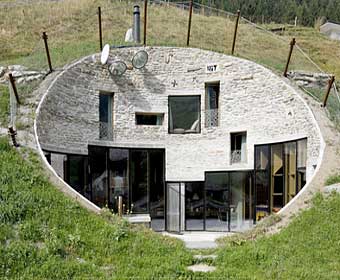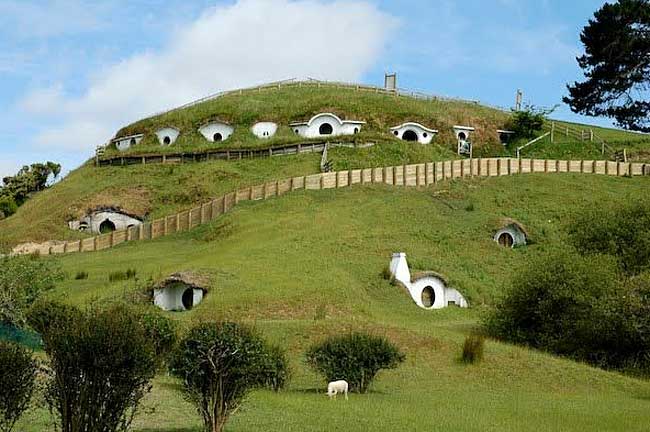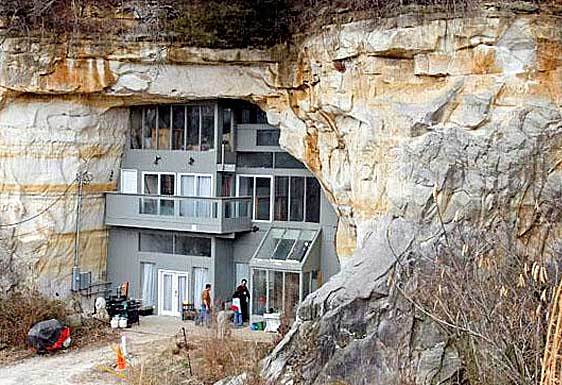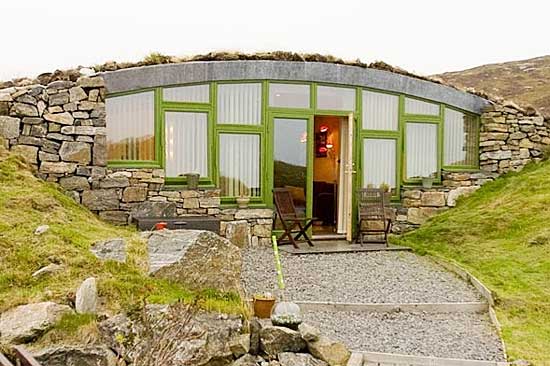Underground
Homes
Eco-friendly homeowners can relax in the knowledge that
their earth-sheltered or underground homes protect them
from almost anything. You'd be surprised how light and
open these houses can be, since "underground"
may have you believing they are like living in the basement
you knew as a child.
 Earth sheltered home
Earth sheltered home |
|
Underground homes are quite self-sufficient, and that's
just one of the reasons they are becoming more popular.
They don't consume as much energy, since the ground provides
their insulation and in many cases, solar power may heat
the home. Some houses include solar collectors, and allow
the sunlight to be captured, and wood fireplaces are excellent
heat sources (though not as green as they emit carbon).
They also allow indoor water to be heated for showers.
Natural Insulation ...
Some types of underground homes have larger portions of
the house above ground, where others appear to almost
blend into the ground that supports them. The living space
in earth-sheltered houses is often below the area frost
line, giving them natural insulation. They may include
other forms of insulation as well, depending on where
they are built.

A Community of Underground Homes
Solar or Fire?
During days when heat is needed, below earth houses can
often gather what they need through solar collectors,
but it's nice to have the added crackle of a fire on chilly
evenings. You can dress like it's summer even during the
winter months.
It's a bit tricky getting financing for underground houses,
since many lenders are not accustomed to dealing with
anything other than conventional dwellings. But once the
lenders see the qualities of the homes, they may have
a more open mind. Earth sheltered houses are usually nearly
fire-proof, except for the furnishings, and they resist
wind and earthquake damage.
Debunking Bunkers ...
It's important for potential owners of underground homes
to understand that they are not bunkers in the traditional
sense, nor do they look like bunkers (but they can be
used as storm shelters). They can be quite aesthetically
pleasing.
|
The reduced utility bills
are also very attractive to people looking into
purchasing or building an earth-sheltered home of
their own.
|
 Underground Home in Missouri
Underground Home in Missouri |
Living underground allows a homeowner to have immunity
to most blizzards and tornadoes, and they also can fare
well during times of disasters of man's own doing. If
there comes a time when fuel is no longer available, you
can use solar or wind energy to make your home self-sufficient.
When people tour earth-sheltered homes, they are surprised
at how airy and light they may be. Most people have an
image of a cave or bunker in their mind when they think
of underground housing.
Mucho Grass ...
The heating and cooling of a subsurface home may cost
$200 a year, rather than the more typical $200 a month
if you live above-ground. The homes are clean and quiet
and they're virtually maintenance free. Mowing your roof
in the summer months is a small trade-off.

Modern Underground House
Conclusion ..
.
There are builders who do a lot of work on underground
houses, in various parts of the United States. Some homeowners-to-be
prefer that they do the work by themselves, and this will
save some money, as long as you know how to do the required
work. The excavation is a major undertaking, followed
by adding stones as bases for concrete walls. Consult
with experts in the field if you're building your own
underground house, so that every aspect will be energy-efficient
and attractive.
Written by Kevin Knatloa
First Published on November 05, 2012
Updated November 22, 2013
|